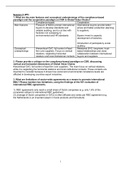Session 5 (PP):
1. What are the main features and conceptual underpinnings of the compliance-based
paradigm and the cooperative paradigm on CSR in Global Value Chains?
Compliance-based Cooperative
Main features Pressure of NGOs prompt international International buyers provide better
buyers to develop standards and prices and better production planning
reliable auditing, and to cut ties with to suppliers;
factories not complying to
environmental and HR standards Buyers invest in capacity
development of factories;
Introduction of participatory social
auditing
Conceptual Hierarchical GVC: full control of lead Relational GVC: long-term, trust-
underpinnings firm over suppliers. Focus on vertical based relationships and close
relations, neglecting horizontal collaboration between international
relations and local institutional contexts buyers and suppliers
2. Please provide a critique on the compliance-based paradigm on CSR, discussing
vertical and horizontal dimensions of Global Value Chains.
Hierarchical GVC: full control of lead firm over suppliers. The main focus on vertical relations,
while it is neglecting the horizontal relations and local institutional contexts. These contexts are
important to consider because it shows how social and environmental compliance levels are
affected in developing countries export industries.
3. What are limitations of sector-wide agreements as a means to promote international
RBC? Please mention two limitations, using the findings of the KIT evaluation of
international RBC agreements.
1) RBC agreements only reach a small share of Dutch companies (e.g. only 1.6% of the
companies adhere to international RBC guidelines)
2) Leverage of Dutch companies in GVCs is often diffused and varies per RBC agreement (e.g.
the Netherlands is an important player in foods products and floriculture)
1
, Sessions 8A, 8B and 11 (PPs and two articles):
1. Please characterize the different, if not: diametrically opposed, views of Herman
Mulder (formerly head of ABN-AMRO’s Group on risk management and
sustainability) and Daisy Termorshuizen (climate campaigner at BankTrack) on
the role of banks in doing no harm but doing good to the climate and in terms
of respect for human rights.
Herman Mulder states that a bank should serve society, so they should provide loans to
everyone that needs it and fits within the demands, like being able to pay back, provide a
business plan, etc. Banks need to be flexible in providing loans, but in conversations they have
to ensure some conditionality for the loan, like setting milestones with the company and
defining what actions they take and not setting others at risk, etc.
Daisy Termorshuizen states that banks should respect human rights and contribute to
environmental sustainability. Banks can influence the behaviour of other companies, because
the companies depend on banks for working capital. Banks have a choice in what companies
they finance.
2. The concept of “value creation for stakeholders” can be considered as umbrella
concept for both interdisciplinary analysis and promoting RBC. Please explain this
by the way in which ABN-AMRO presents its integrated loss and profit statement
(as shown by Herman Mulder in his lecture).
The concept of value creation for stakeholders can be considered as umbrella concept for both
interdisciplinary analysis and promoting RBC, because in the integrated loss and profit
statement of ABN-AMRO, there are four different stakeholder groups: clients, employees,
investors and society for which value is created. Besides, value creation for stakeholders is
specified per capital group: financial, intellectual, human, social, natural, manufactured.
3. In her presentation on behalf of ASN Bank, Emmelien Venselaar distinguished
three ways in which ASN Bank exerts influence on companies to do no harm to
human rights, biodiversity and the climate.
a) Which three ways is ASN Bank using to exert influence on companies to do no
harm?
1) Screening and selection: only investing in officially approved companies.
2) Engagement: engaging in dialogue with companies to improve the company’s behaviour on
environmental, social and corporate governance related issues.
3) Driving and promoting change: being a driving force behind sustainable choices of other
financial institutions.
b) Do you think that ASN, using these three ways, can contribute to substantial
reduction of human rights violations and negative environmental impacts in
high-risk sectors, like the garment industry and the mining industry?
Own answer
c) Based on the presentation of Emmelien Venselaar, would you qualify the
ASN as an ethical bank, or a bank with advanced tools to measure
2





